Color is a major element in any signage. Whether it’s a flag, banner or rigid sign, the colors you use can influence your audience for better or for worse. With Build a Flag’s custom design tool, you can determine the best colors for advertising signs and advertising flags.
Of course, you should design your signage to look exactly how you want, but because of the wide array of meanings that come with colors, planning the design for your signage is critical to present a professional appearance that will resonate with audiences. This post reveals various color associations and the emotions they evoke.
Red signs
Red is filled with energy, zest, and passion. Red signifies life, love, and importance, and tends to elicit feelings related to movement, intense emotion and life, as well as danger. Of course, such an energized color should be used with moderation.Use it to highlight a sign rather than saturate it.
Research from the University of Rochester indicates that the color red may reduce analytical thinking. Researchers found that athletes were more likely to lose when competing against another person or team wearing red and students who were exposed to red prior to an exam performed worse.
Blue signs
Blue is a calming color and is commonly used by businesses. Because blue is found in both water and sky, it is linked to nature and is a very neutral, inoffensive color. It is often associated with productivity and focus. Studies show that weight lifters often achieve greater weights when working out in a blue room.
The meaning of blue varies by shade. Lighter blues are more playful and innocent, and darker blues imply trust and professionalism. This is why many corporate brands are dark shades of blue (IBM, Dell, Facebook, Ford, Intel, American Express).
Yellow signs
Another eye-catching color, yellow is often used in signs as a symbol of happiness, optimism, and cheeriness, most likely due to its association with the sun. Because of its vibrance, yellow is often used for objects intended to stand out like warning signs, taxi cabs and school buses.
Yellow promotes mental activity, logical thinking, creativity, and decision making. Unlike red, yellow elicits analytical thinking. However, too much yellow can increase anxiety and stress, especially for people who are already stressed. Yellow is best used in moderation as a highlight on signage to spark creativity and cognitive activity.
Orange signs
Orange is a vibrant color that represents excitement, warmth, creativity and more. Since orange is a mixture between red and yellow it still carries distorted representations of those colors. Orange carries some of the aggression rooted in red, but is more of a spirited, flamboyant aggression due to the calming effect of yellow. It is often used to represent excitement, optimism and fun.
Orange stimulates mental activity like yellow and also enhances decision making, understanding, and the feeling of assurance. Orange also motivates people to take action, which is why it has become one of the most common colors used for call-to-action buttons on websites.
Green signs
Similar to blue, green is a common color used in business. Green elicits feelings around trust, wealth, nature, health/healing, growth and calmness. Green is often used to represent the earth due to its prevalence in the natural world. Darker shades of green often represent wealth or trust, while lighter shades represent freshness, rejuvenation and excitement.
Green remains one of the more powerful colors for humans because, on a primitive level, green represents the natural world, giving us a positive association. Green is often used by businesses that have some connection to nature (Animal Planet, John Deere, Whole Foods) but the general appeal of the color means it is found in most industries.
Purple signs
Purple is a color with many positive associations. Principally, it is a color associated with royalty and majesty, a connotation that goes back to the Roman Empire. Being born “in the purple” was a sign of Imperial legitimacy with Eastern Roman Empires. Due to its relative rarity as a color until recent history, purple also has connotations of mysticism, rarity, magic and the supernatural. However, it can also represent malice, anger and storms.
White signs
While too much can seem cold and clinical, white can represent any number of good things, such purity, cleanliness and innocence. It is often used when trying to give an impression of freshness and incorruptibility.
In business, white is often used to present a sleek, clean appearance (Apple MacBook) and when paired alongside a strong design, white accentuates it. However, white will exacerbate the appearance of a poor design, making it look bland and unappealing.
Black signs
Black is an excellent contrasting color to incorporate into designs. Black can represent power, sophistication, wealth, security and authority. However, black also has many negative connotations like coldness, evil, oppression and mourning. Black is best used in a simple, elegant design that incorporates at least one other brighter color.
When designing your next piece of signage, consider who will see it, what emotions you want them to feel and pick colors that will help you achieve that. Once you have your colors in mind, get started with our custom design tool and create a professional looking banner, flag or sign.



